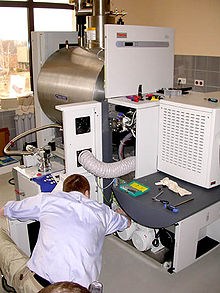Infrared photodissociation spectroscopy

FT-ICR system
|
|
| Acronym | IRPD |
|---|---|
| Classification |
Infrared Spectroscopy Mass spectrometry |
| Analytes |
ion clusters organic molecules biomolecules |
| Other techniques | |
| Related | Spectroscopy |
Infrared photodissociation (IRPD) spectroscopy uses infrared radiation to break bonds in ions, photodissociate, within a mass spectrometer. IRPD spectroscopy has been shown to use electron ionization, corona discharge, and electrospray ionization to obtain spectra of volatile and nonvolatile compounds. Ionized gases trapped in a mass spectrometer can be studied without the need of a solvent as in infrared spectroscopy.
Scientists began to wonder about the energetic of cluster formation early in the 19th century. Henry Eyring developed the activated-complex theory describing kinetics of reactions. Interest in studying the weak interactions of molecules and ions(e.g. van der Waals) in clusters encouraged gas phase spectroscopy, in 1962 D.H. Rank studied weak interactions in the gas phase using traditional infrared spectroscopy. D.S. Bomse used IRPD with an ICR to study isotopic compounds in 1980 at California Institute of Technology. Spectroscopy for weak bonding clusters was limited by low cluster concentration and the variety of accessible cluster states. Cluster states vary in part due to frequent collisions with other species, to reduce collisions in gas phase IRPD forms clusters in low pressure ion traps (e.g. FT-ICR). Nitrogen and water were one of the first complexes studied with the aid of a mass spectrometer by A. Good at University of Alberta in the 1960s.
Photodissociation is used to detect electromagnetic activity of ions, compounds, and clusters when spectroscopy cannot be directly applied. Low concentrations of analyte can be one inhibiting factor to spectroscopy esp. in the gas phase. Mass spectrometers, time-of-flight and ion cyclotron resonance have been used to study hydrated ion clusters. Instruments are able to use ESI to effectively form hydrated ion clusters. Laser ablation and corona discharge have also been used to form ion clusters. Complexes are directed through a mass spectrometer where they are irradiated with infrared light, Nd:YAG laser.
...
Wikipedia
